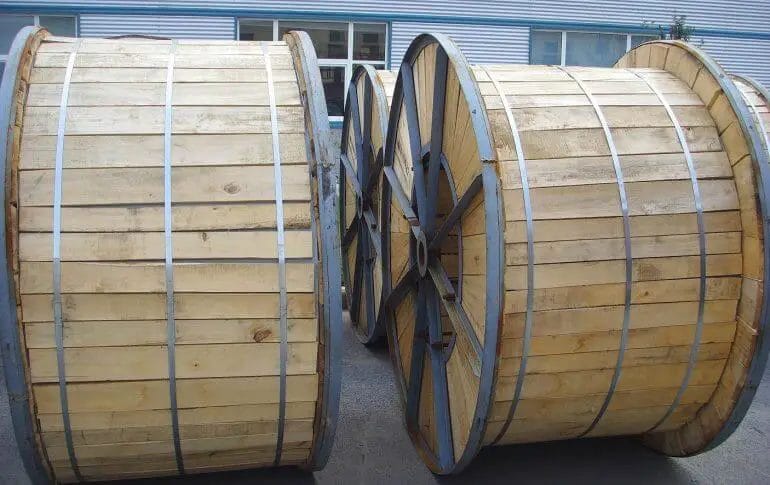Wood is not typically considered a conductor of electricity. Unlike materials such as metals or graphite, wood does not have free electrons that can easily move and carry electric charge. However, wood can still be affected by electricity as it has some resistance and can accumulate static charges.

Properties of Wood That Make It an Insulator
Wood is a natural material that has been used for centuries in various applications. One of its unique properties is its ability to act as an insulator. In this section, we will explore the key properties of wood that make it an excellent insulating material.

1. Cellular Structure
Wood is composed of tiny cells that are arranged in a complex structure. These cells contain air-filled cavities that provide insulation. The air trapped within the wood cells acts as a barrier to heat transfer, making wood an effective insulator.
2. Low Thermal Conductivity
Thermal conductivity refers to the ability of a material to conduct heat. Wood has a relatively low thermal conductivity compared to other common building materials like metal or concrete. This means that heat is transferred at a slower rate through wood, reducing heat loss or gain.
3. Moisture Absorption
Wood has the ability to absorb and release moisture from its environment. When wood absorbs moisture, it increases in volume and creates microscopic air pockets. These air pockets act as insulating barriers, minimizing the transfer of heat. This moisture absorption property makes wood an efficient insulator.
4. Natural Resistance to Heat Transfer
Wood is naturally resistant to heat transfer. Unlike metals, which quickly conduct heat, wood has a slow heat transfer rate. This property helps to maintain a stable indoor temperature, reducing the reliance on external heating or cooling systems.
5. Sound Insulation
In addition to thermal insulation, wood also possesses excellent sound insulation properties. Its cellular structure helps to absorb and dampen sound waves, reducing noise transmission between different areas of a building.
6. Environmental Sustainability
Wood is a renewable resource, making it an environmentally friendly choice for insulation. It can be sourced from sustainably managed forests and does not contribute to greenhouse gas emissions during its production or disposal.
7. Aesthetically Pleasing
Besides its insulation properties, wood also adds a touch of natural beauty to any space. It has a warm and inviting appearance that can enhance the aesthetic appeal of a building or interior.
In summary, wood possesses several properties that make it an excellent insulator. Its cellular structure, low thermal conductivity, moisture absorption capability, resistance to heat transfer, sound insulation qualities, environmental sustainability, and aesthetic appeal all contribute to its effectiveness as an insulating material. These properties make wood a desirable choice for both residential and commercial applications, providing energy efficiency, comfort, and a natural touch to living or working spaces.

Can wood conduct static electricity?
Static electricity is the buildup of electric charge on the surface of an object. It occurs when two objects are rubbed together, causing the transfer of electrons from one object to another. The object that loses electrons becomes positively charged, while the object that gains electrons becomes negatively charged.
When it comes to the conductivity of static electricity, materials can be broadly classified into two categories: conductors and insulators. Conductors are materials that allow the flow of electric charge, while insulators are materials that resist the flow of electric charge.
Wood, being an insulator, does not conduct static electricity. Insulators like wood have tightly bound electrons in their atomic structure, which do not move freely. This makes it difficult for electric charge to flow through them.
Unlike conductors such as metals, wood does not have free electrons that can move around and carry electric charge. Instead, the electrons in wood are strongly bound to the atoms, making it an excellent insulator.
However, it is important to note that while wood itself does not conduct static electricity, the presence of moisture or contaminants on its surface can affect its insulating properties. Moisture can increase the conductivity of wood, allowing it to conduct a small amount of static electricity.
In summary, wood is generally considered an insulator and does not conduct static electricity. It is important to keep this in mind when working with static-sensitive materials or in environments where static electricity can cause damage or safety hazards.

Comparing the Conductivity of Wood with Other Materials
When it comes to conducting heat, different materials have varying levels of conductivity. Conductivity refers to the ability of a material to transfer heat or electricity. In this section, we will explore the conductivity of wood and compare it with other common materials.
Wood is a natural insulator, which means it has relatively low conductivity compared to metals and some other materials. This property makes wood an excellent choice for various applications, including construction and furniture making, where insulation is desired.
Metals, on the other hand, have high thermal conductivity, allowing them to transfer heat quickly. This characteristic makes metals efficient conductors of heat, which is why they are commonly used in cookware, heat sinks, and electrical wiring.
When comparing the conductivity of wood with metals such as copper and aluminum, it is important to note the significant difference. Copper is an excellent conductor of heat, with a thermal conductivity approximately 100 times greater than that of wood. Aluminum, another highly conductive metal, also surpasses wood in terms of thermal conductivity.
While wood may not match the conductivity of metals, its insulating properties can be advantageous in certain scenarios. For example, wooden structures and furniture provide better insulation against heat transfer compared to metallic counterparts. This can help maintain a comfortable temperature and reduce energy consumption.
Furthermore, wood’s low thermal conductivity allows for better heat retention, making it a suitable material for fireplaces and stoves. Wood-burning stoves, in particular, can efficiently distribute heat to the surrounding space while maintaining safety measures due to wood’s slower heat transfer rate.
The conductivity of wood can also be influenced by factors such as moisture content and grain orientation. Moisture content affects the density of wood, and higher moisture levels can decrease its thermal conductivity. Additionally, wood’s grain orientation can impact conductivity, with heat transfer occurring more efficiently along the grain rather than across it.
It is worth noting that while wood may not have the same level of conductivity as metals, its unique properties make it a versatile and valuable material in various applications. Whether it’s providing insulation, enhancing aesthetics, or contributing to sustainability efforts, wood continues to be a popular choice in industries and everyday products.
| Material | Thermal Conductivity (W/mK) |
|---|---|
| Wood | 0.04 – 0.12 |
| Copper | 401 |
| Aluminum | 237 |
In summary, wood has lower thermal conductivity compared to metals like copper and aluminum. While metals excel in conducting heat, wood’s insulating properties make it a valuable material for construction, furniture, and other applications where maintaining temperature and reducing energy consumption are important.
Practical Applications of Wood’s Electrical Insulating Properties
Wood, apart from being a versatile and sustainable material, possesses excellent electrical insulating properties that have paved the way for various practical applications across industries. In this section, we will explore the different use cases and benefits of utilizing wood as an electrical insulator.1. Electrical Utility Poles
One of the most common applications of wood’s electrical insulating properties is in the construction of electrical utility poles. Wood, particularly species like pine and cedar, exhibits high dielectric strength, making it suitable for withstanding the electrical stresses encountered in overhead power transmission and distribution lines. These wooden poles act as reliable insulators, preventing electrical leakage and minimizing the risk of electrical accidents. Additionally, wood’s natural resistance to corrosion and decay ensures the longevity and durability of these utility poles.2. Electrical Enclosures and Cabinets
Wooden enclosures and cabinets are widely used in the electrical industry to provide insulation and protection for various electrical components, such as switchgear, control panels, and transformers. Wood’s insulating properties help to prevent electrical contact and short circuits, ensuring the safe operation of these electrical devices. Moreover, wood’s aesthetic appeal and ability to absorb vibrations make it an ideal choice for enclosures in sound-sensitive environments.3. Insulating Flooring and Wall Panels
Wooden flooring and wall panels not only add beauty to interior spaces but also serve as effective electrical insulators. These panels are used in areas where electrical isolation is required, such as server rooms, laboratories, and cleanrooms. Wood’s insulating properties help maintain a safe environment by reducing the risk of electric shock and preventing electrical interference in sensitive equipment.4. Insulators for Electrical Appliances
Wood is also utilized as an insulating material in electrical appliances to ensure user safety and prevent electrical malfunctions. Many household appliances, such as toasters, blenders, and coffee makers, incorporate wooden handles and knobs to provide insulation between the user and the electrical components. Wood’s natural thermal resistance and low electrical conductivity make it a reliable choice for such applications.5. High Voltage Insulators
In high voltage applications, where electrical insulation is critical, wood has been historically used as an insulating material in the construction of insulators. These insulators support and suspend electrical conductors, such as overhead power lines, while maintaining electrical isolation. Wood’s high dielectric strength and resistance to electrical tracking make it suitable for handling the high voltages encountered in power transmission and distribution systems.6. Electrical Conduit Systems
Wooden conduit systems, also known as raceways, are used for routing and protecting electrical wiring in residential, commercial, and industrial settings. Wood’s insulating properties ensure the safe passage of electrical conductors without the risk of electrical interference or short circuits. Additionally, the natural fire resistance of certain wood species adds an extra layer of safety to these conduit systems. In summary, wood’s electrical insulating properties have found diverse practical applications in various industries. Whether it is for electrical utility poles, enclosures, flooring, or high voltage insulators, wood serves as a reliable and sustainable choice for ensuring electrical safety and efficiency. The unique combination of wood’s insulating capabilities, durability, and aesthetic appeal makes it a desirable material across a wide range of electrical applications.FAQs
Is wood a conductor of electricity?
No, wood is not a conductor of electricity. It is an insulator, meaning it does not allow the flow of electric current through it. This is why wood is often used as an insulating material in electrical applications to prevent the risk of electric shocks or short circuits.
Conclusion
In conclusion, wood is not a conductor of electricity. Unlike metals or other materials with high conductivity, wood is an insulator, meaning it does not allow the flow of electric current. This is due to the structure of wood, which is mainly composed of non-conductive organic compounds and cellulose fibers. Therefore, using wood as a material for electrical components or circuits is not recommended.
However, it is important to note that moisture or impurities in wood can slightly increase its conductivity. So, caution should still be exercised when working with electrical equipment near wood or in moist environments to prevent any potential risks. In general, it is always best to rely on proper electrical conductors for safety and efficiency in electrical systems.